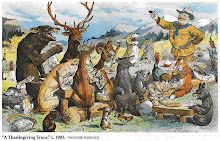Conservationists want clampdown on traffic in Alberta grizzly country
But problems with all-terrain vehicles, dirt bikes and other vehicles remain despite the ban.
"Nobody was ever saying the grizzly bears are in trouble because of the hunt and nobody was ever saying that removing the hunt was going to fix the problem," said Nigel Douglas, a conservation specialist with the Alberta Wilderness Association.
"The problem is access in grizzly bear habitat. We remove one simple source of grizzly bear mortality but we still have plenty of others with the access that we have," he said Monday at a news conference in Calgary.
A number of environmental groups are calling for an immediate moratorium on new roads and serious restrictions for sensitive areas in a long, narrow strip that runs north along the Rocky Mountains from the U.S. border.
"Now that grizzly hunting is on hold, the primary cause of bear deaths is too much contact between bears and people due to motorized access into their habitat," said Wendy Francis, Program Director for the Yellowstone to Yukon Conservation Initiative.
"There's often a conflict that doesn't end up well for the bear," she said. "The bears are being shot by hunters ... who mistake them for black bears or hunters who come in conflict with bears that go after the animal that (the hunters) have killed or people who have a negative interaction with a bear and the bear ends up being removed by a conservation officer."
Francis said bears that are removed have a 30 per cent chance of dying earlier than they normally would. There were 23 grizzly bears who died in 2010 as a result of human contact ."The majority of bears die within 500 metres of a motorized access route. You're simply increasing the risk. When you've got a motorized route you're increasing the risk of there being a person there with a firearm — a poacher, a hunter, whatever — and that's how they die," said Dianne Pachal, an Alberta director with the Sierra Club of Canada.
The organizations say Sustainable Resource Development is more than two years behind in implementing guidelines for "motorized access" that were specified in its grizzly bear recovery plan."There are trails that are open to dirt bikes and trails that are open to quads, and seismic lines are also passable by motorized vehicles," said Sarah Elmeligi from the Canadian Parks and Wilderness Society.
"We have been forced to take this strong position and are asking for no new road construction in core grizzly bear habitat in the province."We're not asking the Alberta government to do anything outlandish. We're asking it to honour the commitment it has already made."









No comments:
Post a Comment